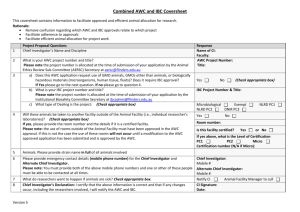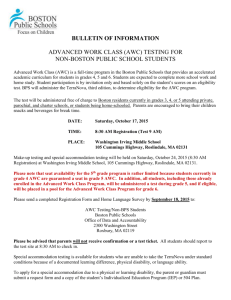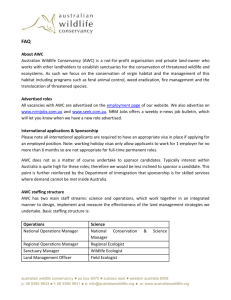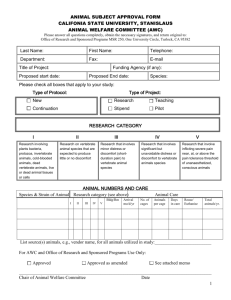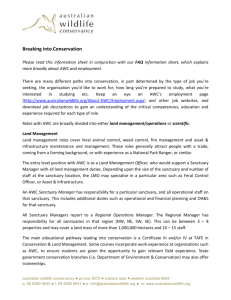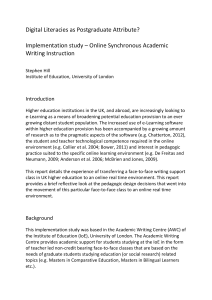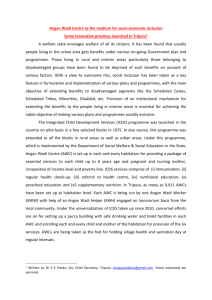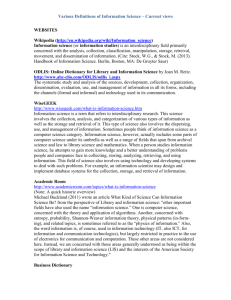Sackville Waterfowl Park - the Acadia Institute of Case Studies
advertisement
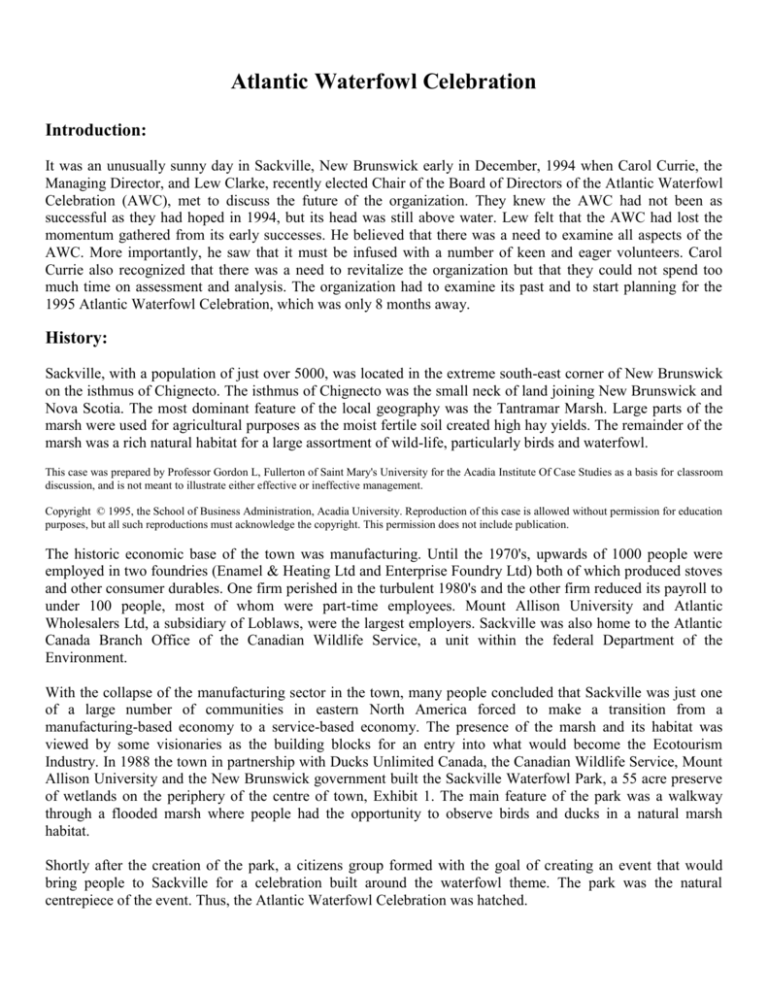
Atlantic Waterfowl Celebration Introduction: It was an unusually sunny day in Sackville, New Brunswick early in December, 1994 when Carol Currie, the Managing Director, and Lew Clarke, recently elected Chair of the Board of Directors of the Atlantic Waterfowl Celebration (AWC), met to discuss the future of the organization. They knew the AWC had not been as successful as they had hoped in 1994, but its head was still above water. Lew felt that the AWC had lost the momentum gathered from its early successes. He believed that there was a need to examine all aspects of the AWC. More importantly, he saw that it must be infused with a number of keen and eager volunteers. Carol Currie also recognized that there was a need to revitalize the organization but that they could not spend too much time on assessment and analysis. The organization had to examine its past and to start planning for the 1995 Atlantic Waterfowl Celebration, which was only 8 months away. History: Sackville, with a population of just over 5000, was located in the extreme south-east corner of New Brunswick on the isthmus of Chignecto. The isthmus of Chignecto was the small neck of land joining New Brunswick and Nova Scotia. The most dominant feature of the local geography was the Tantramar Marsh. Large parts of the marsh were used for agricultural purposes as the moist fertile soil created high hay yields. The remainder of the marsh was a rich natural habitat for a large assortment of wild-life, particularly birds and waterfowl. This case was prepared by Professor Gordon L, Fullerton of Saint Mary's University for the Acadia Institute Of Case Studies as a basis for classroom discussion, and is not meant to illustrate either effective or ineffective management. Copyright © 1995, the School of Business Administration, Acadia University. Reproduction of this case is allowed without permission for education purposes, but all such reproductions must acknowledge the copyright. This permission does not include publication. The historic economic base of the town was manufacturing. Until the 1970's, upwards of 1000 people were employed in two foundries (Enamel & Heating Ltd and Enterprise Foundry Ltd) both of which produced stoves and other consumer durables. One firm perished in the turbulent 1980's and the other firm reduced its payroll to under 100 people, most of whom were part-time employees. Mount Allison University and Atlantic Wholesalers Ltd, a subsidiary of Loblaws, were the largest employers. Sackville was also home to the Atlantic Canada Branch Office of the Canadian Wildlife Service, a unit within the federal Department of the Environment. With the collapse of the manufacturing sector in the town, many people concluded that Sackville was just one of a large number of communities in eastern North America forced to make a transition from a manufacturing-based economy to a service-based economy. The presence of the marsh and its habitat was viewed by some visionaries as the building blocks for an entry into what would become the Ecotourism Industry. In 1988 the town in partnership with Ducks Unlimited Canada, the Canadian Wildlife Service, Mount Allison University and the New Brunswick government built the Sackville Waterfowl Park, a 55 acre preserve of wetlands on the periphery of the centre of town, Exhibit 1. The main feature of the park was a walkway through a flooded marsh where people had the opportunity to observe birds and ducks in a natural marsh habitat. Shortly after the creation of the park, a citizens group formed with the goal of creating an event that would bring people to Sackville for a celebration built around the waterfowl theme. The park was the natural centrepiece of the event. Thus, the Atlantic Waterfowl Celebration was hatched. At the time there was one other community event in eastern North America with a waterfowl theme. The Easton Waterfowl Festival was held annually in November in Easton, Maryland. This event generally coincided with the annual waterfowl migration through the area. This event was primarily an art show and sale featuring paintings, carvings and photographs of waterfowl and their habitat. The target audience was upper middle-class art collectors and duck hunters. Each year several thousand visitors attended the Easton Waterfowl Festival from a market area that extended from southern Pennsylvania-New Jersey to Virginia. The Sackville group realized that their event would have to have broader appeal due to the much smaller market. Nevertheless, they viewed Easton as a model for their own celebration. Purpose: The founders agreed that the AWC would have three equally important pillars: artistic and cultural aspects of waterfowl and the marshlands, outdoor activities relating to the waterfowl theme, and environmental education relating to waterfowl and marshlands. These pillars represented three distinct and disparate markets: art-work collectors, hunters and environmentally concerned citizens. The AWC's vision of itself was that of an umbrella organization covering a series of events and activities which were interesting and relevant to the three markets. Despite the fact that there was wide agreement on its purpose, the AWC did not have a formal mission statement. The Beginnings: Atlantic Waterfowl Celebration was incorporated as a non-profit organization in 1989. It was not permitted to organize as a registered charity because significant aspects of its operations were in the tourism industry. Such organizations were not deemed to be "charitable" by the New Brunswick government. AWC was governed by a board of directors who reflected a number of interest groups in the community. Excerpts from the AWC Bylaws can be found in Exhibit 2. The first event was held in mid-August 1990. This time of the year was chosen because it coincided with the annual migration of shore-birds at nearby Dorchester Cape. It was felt that tours of this feeding area would be a main attraction of the AWC. The volunteer board hired a full-time staff person to complete the legwork involved with setting up and running a community event of this magnitude. This person was responsible for the day to day running of the AWC and also spent considerable time coordinating the activities of the numerous volunteer and board committees. Exhibit 2 contains a description of the AWC committee structure. Financing: In the year that led up to the first AWC, the board expended considerable effort on fundraising. A significant portion of the funding for the first AWC came from local, provincial and federal governments; funding totalled approximately $45,000. Some of these grants were tied to specific purposes, usually in the form of wage subsidy grants such as Challenge or Employment and Immigration Section 25 grants. Private donations and corporate sponsors contributed slightly under $43,000 in that first year. Revenues from AWC activities amounted to about $99,000, the largest part of which was earned from the sale of souvenirs and AWC memorabilia. There were also significant start-up costs involved with putting on the first AWC, including almost $61,000 spent on marketing and promotions. Despite this, the AWC managed to show a slight profit in its first year. It attracted slightly over 2000 visitors. Over the next four years the AWC, like many other organizations in the public and non-profit sector, was forced to do more with less. Despite the increasingly constrained resources, the AWC was able to grow in size and stature. In 1992, the AWC received the Governor General's Award for Conservation from the Tourism and Industry Association of Canada. In 1994 it continued to be recognized by the New Brunswick Department of Economic Development and Tourism as one of the top 20 tourism related events in New Brunswick. The AWC was able to roughly break-even in each of its first four years, although it continued to be heavily reliant on government funding. Lew had recently received the preliminary financial statements from the auditor which showed that the AWC lost just over $13,000 in 1994. Clearly, the AWC could not afford another year like 1994. Income statements and balance sheets from 1990 to 1994 can be found in Exhibit 3. Lew and Carol recognized that the AWC was still quite reliant on government grants and support in 1994, even though government support had decreased over the years. They felt that their revenues from the public sector would continue to decline, so raising all other forms of revenue would have to be the priority. Events: The first AWC had a slate of events from each of the three pillars. Many of these events and activities would be held in subsequent years and would become "flagship" AWC events. The Duck Decoy auction was one of the most important events. It appealled to hunters because many of the decoys at the auction were "working decoys" in that they could be used during the hunting season. This event also had considerable appeal to art collectors because the decoy was an art form that attracted decoy collectors throughout Atlantic Canada. At the low end of the price scale, decoys sold for a few dollars while top end decoys sold for upwards of $1000. The AWC earned a 10% commission from decoy sales. Carol knew that the drawing power of this event was directly related to the quality of decoys available for auction. Carol expressed some concern that the event had decreased in stature due to a decline in decoy quality. Another major "pillar" event was the waterfowl carving competition and exhibition. The competition attracted some of the major artists in Atlantic Canada. The competition provided the artists with the opportunity to test their carving skills against those of their peers. While most of the competitive works were not for sale, several exhibitors had other carvings for sale. The exhibition provided the artists with exposure to a group of collectors or potential collectors. In 1993, a taxidermy competition and exhibition were added, although the competition and exhibition were not as large as the carving exhibition and competition. The competitions were held in the same venue as the AWC trade show. The trade show provided an opportunity for a number of businesses, nonprofit organizations and government agencies to display and to sell products and to communicate information. Typical exhibitors included: Ducks Unlimited, Environment Canada, competing and non-competing carvers, a carving equipment supplier, a canoe vendor and a hunting supply dealer. In 1993 and 1994 approximately 30 exhibitors were present. Carol felt that exhibitors were satisfied in 1994 even though attendance was down. Another important event was the art exhibition, sale and silent auction. The exhibition permitted artists to display paintings, photographs, carvings and other works that were available for sale. Once again, the AWC earned a commission on the sale of these items. Many artists donated works to be sold in a silent auction. The AWC received all of the proceeds from the sale of these donated items. The Sackville Waterfowl Park was the site for a number of park tours that allowed visitors the opportunity to see and to learn about ducks and other birds inhabiting the park. The tours were led by a number of qualified guides, including experts from the Canadian Wildlife Service. The AWC also provided tours to a number of other sites, such as Dorchester Cape to see the migrating shore birds and Amherst Point (Nova Scotia) to see the bird sanctuary. Over the next four years, the programme of events was to be expanded but all new events were expected to fit with the basic theme of the AWC. The AWC hoped to add a new event, if it was possible to organize it and to fit it within at least one of the three pillars of the AWC. A few events, specifically the duck calling competition and the retriever demonstration have gathered a large following among people with an interest in duck hunting. Even though several events have been added, Currie and Clarke both considered the Decoy Auction, the Carving and Taxidermy Competition /Exhibition, the Trade Show, the Tours and the Duck Calling Competition to be the flagship events of the celebration, as they usually attracted large and enthusiastic crowds. The AWC was fortunate because there were a large number of venues available in Sackville. A significant amount space was rented from Mount Allison University but other indoor and out-door sites were used in the community. Exhibit 5 provides a detailed programme of events and venues from the 1994 AWC. Customer Analysis: In 1993, groups of marketing students at Mount Allison University conducted projects on the AWC as part of the requirements in a marketing research course. The AWC already had a good knowledge of the geographic market area because visitors were asked to complete a stub providing their name, address and phone number when they purchased event tickets or passes. Exhibit 4 contains a geographic profile of AWC visitors from 1993. The 1993 profile is thought to be similar to the visitor profile from previous years. A sample was randomly selected from the pool of ticket stubs available from the 1992 AWC. Selected visitors were contacted and asked to complete a lengthy questionnaire by mail. This market research provided a more detailed demographic and attitudinal profile of AWC visitors. Lew Clarke noted that, "This work was useful because it enabled us to find out who our customers were so that we could better develop events that would be interesting to them." Carol Currie mentioned that, "The AWC marketing committee had used this information in the hope that advertising and communications could be used to reach more people similar to the current visitors." Some of the major findings of these student projects appear in Exhibit 6. Carol's Arrival in 1993: Carol was hired as managing director in late June 1993, when the previous managing director resigned in order to move to another community. "I arrived in the office and I was expected to manage this Celebration that was taking place in six weeks and but I first had to find out what it was all about," said Carol, talking about her first few weeks on the job. Even though Carol was new to the job of Managing Director, the 1993 AWC was arguably the most successful AWC to date. Lew felt that the 1993 AWC was successful because of the high level of activity existing in the town during the three days of the celebration. "Clearly," said Lew, "our high spending on promotion did its job, but in the end we lost money." The communications goal in 1993 was to generate awareness and interest throughout the entire Maritime region, not just south-eastern New Brunswick and northern Nova Scotia. Lew admitted that a few board members felt that the 1993 communications campaign had gone overboard in its efforts. Marketing and Communications: Since its inception, the AWC had always taken marketing seriously. In the early years, the AWC retained a close association with a local advertising agency. An agency was commissioned to design a poster for the 1991 Celebration which won an international advertising award for community events. The poster was an important part of the communications programme. For each of the first four years of the AWC, a poster was designed around a strong visual image that related to the celebration or one of its pillars. "The AWC poster is a marketing tool but it is also a work that is important in its own right because of the strong visual imagery contained in the poster," said Carol Currie. Each year, several hundred posters were distributed to retail stores, motels, bed & breakfasts and tourist information centres in New Brunswick. Posters were also sold as souvenirs. It was also recognized that posters from previous years continued to provide benefit to the AWC. Lew Clarke summed up the view of the executive with the following: "I am sure that I could walk into a 'Bed & Breakfast' somewhere around St. Andrew's and see our 1991 poster displayed in the lobby. Now mind you, the date and year would be wrong, but some tourist from Connecticut walks into this B&B today and instantly they are aware of the AWC and they have a pretty strong sense of what we're all about from this poster. Our hope is that they will become interested enough to seek more information from tourist information centres." The AWC printed a brochure which was primarily distributed through Provincial and Community Tourist Information Centres. Each year approximately 10,000 brochures were required. Lew acknowledged that the brochure was an important tool in reaching tourists, who seek information about things to do in New Brunswick when they enter the province. In 1993, another Sackville advertising agency did substantial redesign work on the brochure. Printing and redesign work cost $12,000 in 1993, although several thousand brochures were still available for use in 1994. By the end of 1994, the AWC had run out brochures and a reprint was necessary in 1995. The AWC also made sure that the event was listed and identified in the section outlining festivals and events in the large New Brunswick tourist information guide. Throughout its history, the AWC has used radio as a communication medium. In the early years, the radio buy was concentrated on stations in Moncton, NB and Amherst, NS. The Moncton stations had good reach throughout southern New Brunswick, while the Amherst station reached the local market including Sackville. Radio can bean expensive medium, but most stations offer a one for one (one free advertisement for every purchased advertisement) and supplement the bought time with public service announcements. In 1993 the marketing committee recommended a strategy of expanded radio coverage. As a result, AWC bought time on stations in Halifax (C-100, CJCH), Truro (CKTO), Antigonish (CJFX) as well as Amherst (CKDH) in Nova Scotia, and Moncton (CKCW,CFQM), Saint John(C-98) and Fredericton (CIHI) in New Brunswick. The AWC also purchased some air time on CHMA, the campus radio station at Mount Allison. Carol Currie stated that, "This radio buy was part of our strategy to widen the appeal of the celebration. How can we expect people in Halifax, Truro or Saint John to make the decision to drive to Sackville for the day or weekend if we haven't made them aware of the Atlantic Waterfowl Celebration ?" The AWC benefited from a New Brunswick Department of Tourism subsidy programme that paid for 50%, of the buy in out of province media. It did not provide any subsidy for printing or creative development. The AWC successfully applied for this programme in 1993 but did not qualify in 1994 because the budget had been allocated by the time AWC applied to the programme, even though they met the formal application deadline. Carol has found out that the 1995 application had been approved. The AWC also made extensive use of signage on the highway near the Sackville exits and in the town during the weeks leading up to the event. Planning for the 1994 Celebration: Everyone involved with the AWC felt that it would be difficult to top the success of the 1993 AWC. Funding became a top priority. Lew Clarke had the following comments about the 1994 fundraising plan, "Everyone felt that we had to reduce our reliance of government money. The reality is that government funding is risky because it can disappear at any time. We had to reduce our reliance on government funding by developing a stronger corporate business and personal sponsorship programme." The AWC had always sought money from the business sector in two ways: large regional businesses were approached as corporate sponsors while smaller local businesses were identified as possible event sponsors. In 1993, corporate sponsors included Irving Oil, Atlantic Wholesalers and Pizza Delight, while the event sponsors included a local grocery store and an auto dealership. In addition to its problems on the revenue side, the AWC also found itself in the middle of a debt crunch. At the end of 1993, the AWC had an accumulated debt to the town of about $31,000. This debt existed because the AWC managing director was formally on the payroll of the town of Sackville. The town paid the employee and the AWC reimbursed the town. This practice stemmed from the early days of the AWC when it operated out of an office in the back of town hall. In early January of 1994, the executive committee met with the Mayor and Town Comptroller in order to work out a debt repayment plan. It was agreed that the AWC would repay $9000 in each of the next 3 years and the remainder in the fourth year. There would be no interest charges during this time, however, the town would no longer act as paymaster for AWC employees. The AWC executive were somewhat relieved that the town did not ask for payment in full. They took this generosity as evidence that there was still considerable support for the event among local politicians. As of December, 1994 all of the current portion of the debt to the town of Sackville was still outstanding. The need for positive cash flow lead to the development of a very ambitious corporate sponsorship programme. "We all thought we could raise $30,000 from the corporate sector and $10,000 in individual event sponsorships," stated Carol. Carol, the former chairperson of the board and the chair of the marketing committee, had a number of meetings with Atlantic Canadian Businesses in the early months of 1994. "We were quite disappointed with the results of our work but we learned that we had to start earlier in the year and be much more aggressive in our dealings with corporations," said Lew, when discussing the 1994 efforts. The AWC was able to raise only $6,000 in the form of corporate sponsorships in 1994, much less than it had raised the year before. The results of the event sponsorship campaign were better even though they fell quite short of their objectives. In 1994, the AWC raised $7,350 from individual event sponsorships. Also in 1994, they undertook a more aggressive direct mail campaign. They had a list of previous donors and a list of previous visitors to the celebration. Carol commented, "Raising money from personal donations has always been difficult because we couldn't provide a tax receipt. We have gone to the same well too many times, we had to broaden the donation base. Previous visitors to the celebration were a natural target because they had at least some interest in the AWC and our purpose." The personal donations programme was moderately successful in 1994, raising $5,650. By early 1994, the AWC's committee structure had disintegrated. Few, if any, committees met on a regular basis. Carol found that she was spending more of her time organizing AWC events rather than on coordinating the activities of the volunteer committees. Carol took her direction from a small five-person active executive committee that was extremely dedicated to the organization. The full board of directors retained the format outlined in the Bylaws and it met the required three times per year, but the full board generated few new ideas. The board seemed content to let the executive run the show and the executive committee was content to run the AWC without much input from a broader group. Just prior to the 1994 Celebration, two of the five members of the executive committee announced they would be leaving Sackville to take jobs in other communities. Lew Clarke commented, "We originally thought we were looking to fill two key executive positions, but the more we thought about our situation, we realized we had some serious troubles with our whole structure." He went on to say that, "The formula outlined in the Bylaws was great as a means of representing important groups in the community, but it was lousy for getting things done." There was still a strong core of volunteers to complete specific tasks. Lew noted that, "The AWC wasn't really short of volunteers during the celebration or in the weeks leading up to it, but Carol was doing most of the work and the executive seemed to putting in a lot of time." The marketing programme for the 1994 AWC was less elaborate than the 1993 campaign. The biggest change was that the AWC produced a poster that was less elaborate than those produced in previous years. Design and print work for a four-colour separation poster could cost over $3000. Carol said that the low budget poster was purely a promotional device rather than a creative work that would last for years. Lew pointed out that there was an expectation both in and outside the community that a collectible poster was an important part of the AWC's marketing programme. "When we produced a piece of junk," said Lew, "it sent a signal to the community that all was not well in our little organization." The AWC did manage to scrape together a few dollars for a radio campaign on local stations CKDH (Amherst) and CKCW/CFQM (Moncton) during the days leading up to the celebration. One other change made in 1994 was the pricing. In previous years, visitors could buy three-day passes, one-day passes or individual event tickets. They raised the price of a three-day pass from $14 to $25 and the price of a day-pass from $7 to $10. Individual event tickets were eliminated. Carol said that the goal was to significantly raise AWC's revenues from event attendance, but they fell far short of that goal. Some members of the Executive Committee felt that the AWC was a premium quality event and that a premium quality price was required. Lew noted that the price increase decision was made by the executive committee without much consultation from the full board. "Perhaps," said Lew, "this is the best example illustrating how out of touch we had become." The 1994 Celebration: The 1994 celebration was successful on some fronts and a disappointment on others. Carol was enthusiastic about the number of new exhibitors and competitors entering the carving and taxidermy competitions. She was also excited about the number of new vendors who rented booths in the Fundy Eco-Fair which was the new name given to the trade-show. "We felt that the word trade show had a meaning which was not what we wanted. We were more interested in creating a type of market where vendors producing or selling artwork and outdoor-type products could reach our visitors," Carol said, in commenting on this event. Perhaps the greatest disappointment and the most embarrassing shortcoming of the 1994 AWC was the cancellation of the Duck-Calling competition at the very last minute. "We had tickets sold and an audience in the hall, but only two competitors," said Currie. We gave a very interesting impromptu duck-calling demonstration but it was clearly not the event that we or the audience expected." Lew and Carol agreed that the Duck-Calling competition fell apart because of conflict among the volunteers charged with organizing the event. Attendance and revenues were down from 1993. Carol and Lew were not sure how much of this decline could be attributed to the lower profile resulting from less advertising, how much was a result of a negative reaction to the price increases and how much of it could be attributed to other factors, including the weather and competing events in the region. The 1994 AWC was held on the same weekend in August as the Acadian Homecoming, held in many francophone communities in south-eastern New Brunswick. "Originally we thought this one time event would bring a large pool of visitors to the region from Quebec, elsewhere in Canada and the southern U.S. and we would receive some spill over," said Carol Currie. "As it turned out, many people in the area attended events held in conjunction with the Acadian Celebration and chose to not attend the AWC this year," continued Carol. Lew was worried that the AWC no longer had support or interest in the community. The Call: As they were discussing the immediate and long term future of the organization, Carol took a call from a local town councillor. The councillor reported that the town finance committee had completed its preliminary budgeting exercise for 1995 and it would reduce its grant to the AWC in 1995 by about $8,000 and that none of this would be disbursed until the AWC had paid the Current $9000 portion of the debt owed to the town. Carol and Lew agreed that this new information made a major impact on both the reorganization and the development of a marketing plan in 1995. Exhibit 1 Map of Sackville and the Sackville Waterfowl Park Sackville Waterfowl Park As you tour the Sackville Waterfowl Park, keep your eyes and ears open for the sights and sounds of wetland wildlife. More than 140 species of birds and at least six species of mammals have been recorded here. Interpretive signs will tell you about some of the most common ones. A checklist and more detailed tour information may be obtained from the Sackville Tourist Information Centre or the Town Hall. Source: Town of Sackville, “Sackville, New Brunswick: Where You Belong” Exhibit 2. Excerpts from the AWC Bylaws Objectives: In conjunction with the "Objects" et forth for the AWC in its Letters of Patent, the "Atlantic Waterfowl Celebration" will be organized each year as a three day festival of outdoor recreation, arts, crafts and family fun dedicated to the appreciation of our natural heritage of wetlands and wildlife. Our objectives are: - to organize promote and manage the Atlantic Waterfowl Celebration as an annual festival centred in Sackville, New Brunswick; - to promote, through the themes and activities of the Atlantic Waterfowl Celebration, the kind of interest and pride in our community which encourages tourism and enhances business; - to operate the Atlantic Waterfowl Celebration so that it generates enough revenue to become and remain self-supporting; - to generate whenever possible , enough revenue to provide financial support to our Sackville Waterfowl Park, and other features of our community's natural heritage. - to support, in general, environmental education and the preservation and enhancement of wildlife habitat. Article 1 - Board of Directors 1.1 Board: The management and control of the business and affairs of the AWC shall be vested in a Board of Directors, consisting of such number of persons as shall from time to time be invited to join the Board of Directors, as herein provided. 1.2 Directors: The Board of Directors shall be composed of the following: 1.2.1 One representative (except as noted) delegated by each of the following organizations, invited to affiliate with AWC Town Council (2) Town Administration (2) SEDCO (Sackville Economic Chignecto Naturalist Club Sackville Rod&Gun Club Sackville Rotary Club Development Commission) (2) Sackville Kinsmen Club Canadian Wildlife Service Sackville Lions Club Ducks Unlimited Canada Atlantic Wholesalers Waterfowl Park Advisory Committee Mount Allison University United Church Home for Senior Citizens Tantramar Tourist Association 1.2.2 Other individuals which the Board might choose to invite on the grounds of their participation in the work of the AWC. Article 2 - Officers and Committees 2.1 Officers and Executive Committee: The Board of directors shall elect from among their number a Chairman, Vice-chairman, Treasurer and Secretary to form along with the immediate Past Chairman, the core of an Executive Committee. These officers of the Board of Directors shall also be the officers of the Executive Committee. 2.5 Committees: The officers shall appoint such committee and coordinators as it deems appropriate to carry out the objectives of the AWC, and shall appoint chair-persons for each committee. In so far as possible, the Chair of each standing committee (identified below) will be a director on the Executive Committee. 2.5.1 Finance Committee: To control and supervise the finances of the AWC and its various committees, including the preparation of budgets, managing payments, income and investments, and presentation of annual statements to the board. 2.5.2 Fund-Raising Committee: To develop and recommend a fund-raising strategy from all appropriate sources, and to coordinate all matters concerning its implementation. 2.5.3 Marketing Committee: To develop and recommend the marketing and communication strategies for the AWC and to coordinate all matters concerning implementation. 2.5.4 Information and Sales Committee: To develop and recommend and overall strategy of selling tickets and souvenirs and distributing information and to coordinate the volunteers, use of booths and all matters concerning the implementation of the strategy. 2.5.5 Facilities Committee: To make provision for and coordinate the use of all buildings, signs, parking, security, transportation, accommodations, and all other facilities required. 2.5.6 Events Committee: To develop and recommend an overall plan of events for the AWC, and to coordinate and oversee all scheduled events through those individuals responsible for each event. 2.5.7 Exhibitions Committee: To develop and recommend an overall plan of exhibitions, and to coordinate and oversee all such sanctioned exhibitions through those individuals and/or organizations responsible for each. These committees shall have the power to act only as stated in these bylaws or as authorized by the Executive Committee or Board. All committees shall report to the Executive Committee or Board as requested by the Chairman of the Board and shall submit an annual report to the Annual General Meeting. Exhibit 3 Income Statements (1990-94) 1 Includes revenue from sale of dance tickets. Balance Sheets (1990-94) Exhibit 4 Geographic Profile of AWC Visitors – 1993 Includes Event Tickets, Day Passes, 3 Day Passes Source: Company Files Exhibit 5 Programme of Events from 1994 Atlantic Waterfowl Celebration Source: Company Files Exhibit 6 Major Findings of Student Projects (1992 Visitors) Respondent perception of the AWC. Respondent were asked to state how well the following image described the AWC by using the following scale: For All Questions (n=163), Overall Response Rate = 70%. Source: Company Files
